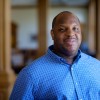This article is more than 5 years old.
“Creating Harmony from Dis-Chord was” the theme of the 2012 NASIG Conference, and with topics ranging from managing e-books, licensing skills and incorporating mobile devices, there were a few disparate notes to be brought together. Steve, Derrik and I made the trip to Nashville with an eight hour drive (one way) in the library van, and discord was not an element of the trip. In that spirit, there were two broad themes of the conference that I took away with me: sharing the unity of a common vision, and finding solutions to emerging problems.
NASIG has invited leading professionals from both inside and outside of the library world to give their insights about the future of libraries, and this year’s conference was no exception. Friday’s speaker was Dr. Lynn Silipigni Connaway of OCLC, and she discussed her research about student research and library workflow. The previous paradigm of academic libraries was that patrons had to work around library-centric workflows, but now it’s the reverse where users have greater influence by having libraries respond to their needs. Dr. Connaway proposed that students should have greater leeway in the direction of library services; personally, however, I wasn’t certain if this would be a correct approach. I would submit that libraries should meet their patrons halfway; while it is ideal to adapt to the changing needs of users, libraries still have something to offer in terms of what their users would need in terms of instruction and self-enrichment. Information literacy is becoming the reality of the 21st century, and a partnership between libraries and their patrons would be beneficial for both groups.
The vision session on Saturday was presented by Kevin Smith of Duke University, and he spoke about the relationship between copyright and new technologies in libraries. He made the point that although lawsuits against libraries are a new phenomenon, the litigation that has been produced has advanced and updated elements of copyright that hadn’t been revised since photocopiers were the dominant technology. Situations regarding fair use now include whether or not new iterations can transform an original work and not compete with it, and whether the amount used within the new work is actually appropriate. Considering recent cases against Georgia State University (involving electronic resources), UCLA (involving streaming media) and the Hathi Trust (digital scans and distribution of “orphan” works via libraries), risk has become part of the procedure as libraries move toward adopting more robust technologies. At the same time, however, the reward of bringing the services represented by these technologies to potential patrons would have an uncalculated value.
On Sunday, the vision session was presented by Rick Anderson, past president of NASIG, who currently works at the University of Utah. Rick has always had interesting things to say about libraries and library procedures, but in his topic “Is the Journal Dead?” pointed to a much larger question in terms of access and the changing nature of research. Rick contended that a new crossroads has been reached for library development, where the ground is still fertile for changes that weren’t possible five years ago and may not be possible two years from now. This is the period where networked environments have changed the model of distribution for resources; a parallel would be the distribution model that emerged not when the music moved from vinyl albums to CDs, but when CDs could be imported into iTunes. Freeing articles from journals can redefine the distribution of that content to the point where journal becomes an afterthought. When asked whether this will mean librarians will be out of a job, he stated that an attachment to professional identity can get in the way of our usefulness. It was definitely food for thought.
The other element of the conference was the problem-solving measures that libraries had taken to address their needs. The most interesting of these sessions was about the CORAL electronic resource management system, featuring three speakers including our own Derrik Hiatt. Derrik and his two co-presenters, each from a different kind of academic library, outlined how they used CORAL to address a specific gap in managing their own electronic resources. As an open-source interface, each library could customize the software around their respective workflows, such as information regarding licenses, contacts, and troubleshooting. Derrik related his own experience extremely well and even had a few people express interest in trying the product themselves-good job!
I’ll end my report with three bits of trivia I learned during the conference.
- The city of Nashville was built around a natural salt lick that attracted herds of animals to the area. The salt lick has since disappeared.
- When sued for their parody of Roy Orbison’s “Oh, Pretty Woman,” 2 Live Crew won the case on the grounds of fair use.
- The Country Music Hall of Fame includes two cars: Elvis Presley’s solid gold Cadillac, and Webb Pierce’s silver dollar convertible.

2 Comments on ‘2012 NASIG Conference According to Chris’
What a timely discussion about 4 very interesting issues. It sounds like a great conference!
[…] posted earlier in his NASIG report about a trend towards meeting user needs now, which matched things I heard in a session called […]